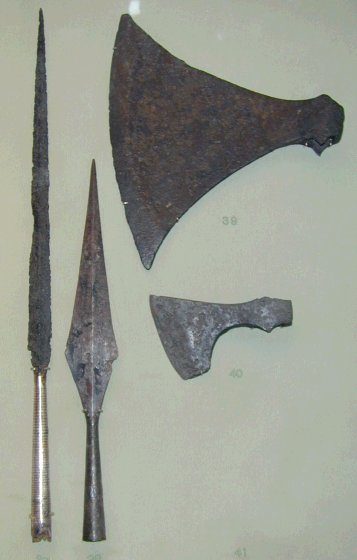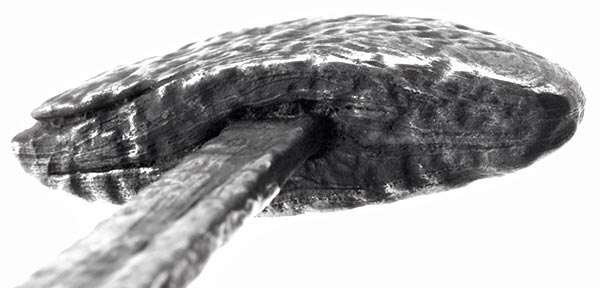| Author |
Message |
|
Jeremy V. Krause
|
 Posted: Mon 07 Aug, 2006 5:37 pm Post subject: Axe head construction Posted: Mon 07 Aug, 2006 5:37 pm Post subject: Axe head construction |
 |
|
Hello everyone,
I have a question regarding how the historic axe head/edge was constructed. On the production market we see both complete axe head and edge made of one type of steel a.k.a. A&A's Danish and Sparth axes and we see axes with high carbon steel edges forge welded onto low or medium carbon bodies like Kirby Wise and Eric McHugh's recent axes. Is either method more authentic for the viking period transitioning into the high middle ages? Were complete monosteel heads seen historically or should someone desiring the highest level of historical accuracy opt for the forge welded edge type?
Thanks everyone- I imagine Craig or Peter may have some thoughts on this,
Jeremy
|
|
  |
 |
|
Johan S. Moen
Location: Kristiansand, Norway Joined: 26 Jan 2004
Posts: 259
|
 Posted: Tue 08 Aug, 2006 2:52 am Post subject: Posted: Tue 08 Aug, 2006 2:52 am Post subject: |
 |
|
At least for the Migration and Viking Era, I'd say a iron socket and body with a welded on steel edge. Some of the larger axes may have had a steel body with an iron socket in my opinion, since the body is usually _very_ thin. This makes for a rather bendable body, especially at the socket-weld...a friend of mine found this out the other day when some kid stepped on his light viking axe. 
I'd say it depended on money, but that a rule of thumb would be to use as little steel as possible. Why waste it when you could use cheaper iron and get acceptable results.
Johan Schubert Moen
|
|
  |
 |
Nick Trueman

|
 Posted: Wed 09 Aug, 2006 1:28 am Post subject: Posted: Wed 09 Aug, 2006 1:28 am Post subject: |
 |
|
Hi
I posted yesterday but it didnt come through? Must because Im related to gumby. Anyway Ive seen examples of both monosteel and high carbon steel welded blade edge axes for the viking age. It was as suggested been totaly up to the economy of the village, availability and status/wealth of the soon to be owner.
War axes did tend to have a thin blade profile, though work axes were wedge shaped not unlike modern ones.
Thats a bit cut dry though as I have seen smaller headed war axes wich are quite wedge shaped.
N
 Attachment: 26.36 KB Attachment: 26.36 KB

|
|
  |
 |
|
Jeremy V. Krause
|
 Posted: Wed 09 Aug, 2006 12:25 pm Post subject: Posted: Wed 09 Aug, 2006 12:25 pm Post subject: |
 |
|
Thanks Johan and Nick,
So that's two responses that monosteel axe heads could have existed along side types having different carbon ratio steels welded together. Reding your posts has helped me understand that the axe head can really have three distinct structures i.e. socket, body, and edge, where I was previously thinking two i.e. body and edge.
Craig J., Eric M., or Peter J. do you have any thoughts on the historical construction of the axe?
Jeremy
|
|
  |
 |
|
Patrick Kelly
|
 Posted: Wed 09 Aug, 2006 1:16 pm Post subject: Posted: Wed 09 Aug, 2006 1:16 pm Post subject: |
 |
|
|
While discussing the axe he made for me, I believe Eric McHugh commented that both styles have been found but the monosteel versions tend to be smaller types. He's done quite a bit of hands-on research on the subject, hopefully he'll chime in. From our discussions on viking axes, pommels, etc., I've gathered that there really isn't one standard way to make these things. The nordic peoples seem to have been very clever in adapting what they had to achieve the desired end by whatever means neccesary.
|
|
   |
 |
Nick Trueman

|
 Posted: Thu 10 Aug, 2006 1:18 am Post subject: Posted: Thu 10 Aug, 2006 1:18 am Post subject: |
 |
|
A little of topic but a nice view here of a forged sword pommel ( viking age).
time and rust has done a favour to us hear, allowing a nice view of construction. Might be worth thinking about with axe construction too?
N
 Attachment: 27.59 KB Attachment: 27.59 KB

|
|
  |
 |
|
Johan S. Moen
Location: Kristiansand, Norway Joined: 26 Jan 2004
Posts: 259
|
 Posted: Thu 10 Aug, 2006 3:11 am Post subject: Posted: Thu 10 Aug, 2006 3:11 am Post subject: |
 |
|
In Norwegian laws from about 1240-1260 and before, they talk about "halvtynna økser" or "half-thinned axes" as a type of axe a warrior should have. Meaning that the body of the axe should be quite thin. There are a few small, almost wedge shaped axes found on Gotland, but if these were working axes or war axes, I cannot say.
Johan Schubert Moen
|
|
  |
 |
Eric McHugh
Industry Professional

|
 Posted: Thu 10 Aug, 2006 7:39 am Post subject: Posted: Thu 10 Aug, 2006 7:39 am Post subject: |
 |
|
Sorry about the non-reponse...my computer took a huge hit, so I'm waiting to get my OS back up...really limited internet access.
In short, the Migration/Viking axes that were weapon grade and size were generally made up of multiple pieces that were forge-welded together. Peter has far more knowledge and experience with this subject than I do, but I do remember him talking about some axes that had as many as six pieces. I believe it is possible for a tool grade axe to be mono-steel, but I don't know this to be fact. I know that the axes I've handled in Sweden were of the multi piece, forge welded type.
I've handled Danish style (early Norman era) axes as well as earlier bearded style (Vendel era) axes. The Vendel era axes appear to have three or more parts: a socket, a body (which is split to accomodate edge steel), and then the edge steel. Data suggests that the socket and body were low carbon or even iron and the edge was higher carbon edge steel. When it comes to the Danish style axes, the socket and body were welded together, but it would appear that the edge steel was forge-welded over the iron body. This creates a swelling that is quite characteristic of the Danish style axes. There is a beautiful example of this in Denmark where the boundry of the edge steel is well defined. No attempt was made to blend the body and edge.
In summary, while it would be wrong to say that migration and Viking axes were never mono-steel, it is fair to say that forge-welding multiple pieces together was the most popular method of construction. Hope this helps.
Find me on Facebook, or check out my blog. Contact me at eric@crownforge.net or ericmycue374@comcast.net if you want to talk about a commission or discuss an available piece.
|
|
   |
 |
|
|

